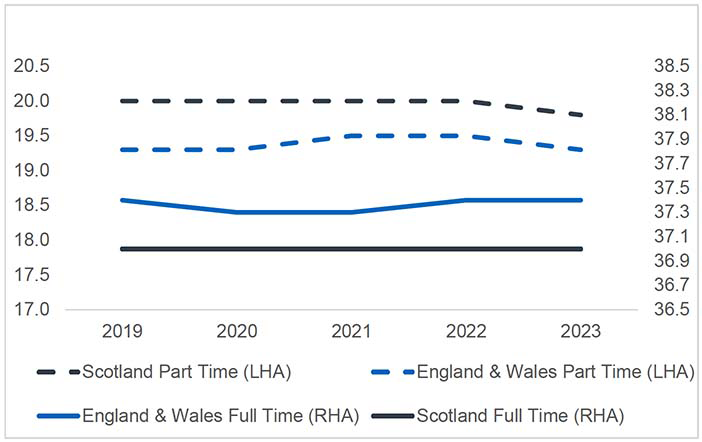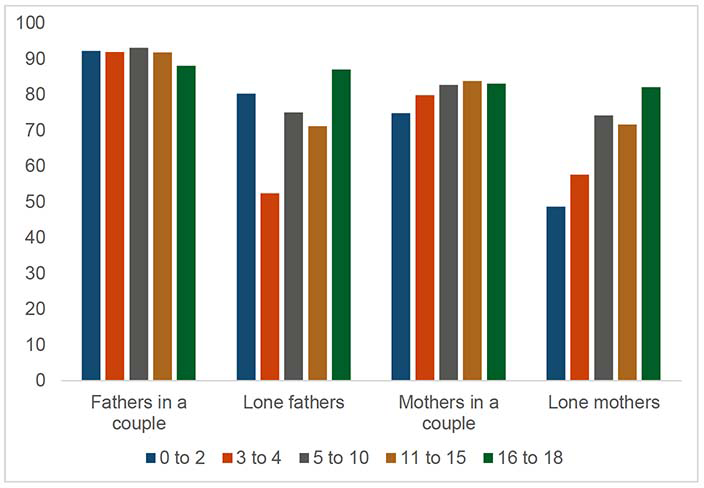Scottish Child Payment and the labour market
This publication presents Scottish Government analysis of how Scottish Child Payment interacts with the labour market in Scotland including how it impacts labour market decisions of its clients.
Labour Market Overview
30. The majority of SCP clients are women. Across the five family payments, 81% of clients responding to the client survey for August – November 2023 identified as women[13]. Previous client survey data also suggests these women receiving SCP are broadly evenly split between living in lone parent and couple households. In couple households the other adult will most often be male and is also likely to have access to SCP income. Depending on household dynamics SCP could affect labour market outcomes of men in addition to women.
31. Latest labour market statistics for Scotland based on the Annual Population Survey show the employment rate of women (aged 16-64) in Scotland is 72.7% for the year ending December 2023[14]. This is slightly higher but broadly similar to the UK as a whole (72.2%).
32. The gap in employment rates for men and women has narrowed significantly in Scotland and the UK over the past 20 years as employment rates for women have risen steadily. However, employment rates for women remained around 4 percentage points lower than for men (72.7% vs 76.9%) in Scotland in 2023.
33. There were around 1.3 million women in work in total in Scotland in 2023. Women who receive SCP are likely to represent around 100,000 of this total, so less than 10%. Unless SCP had very significant effects on labour market outcomes it would be difficult to identify an SCP effect on these headline labour market statistics.
34. The Office for National Statistics (ONS) Annual Survey of Hours and Earnings[15] is the most robust measure of the hours worked and paid earnings of labour market participants in the UK. Although SCP clients cannot be isolated within this data, it can be used as a general guide to the trends of worked hours and earnings in the economy.
35. Figure 2 shows there has been very little change to the average (median) hours worked per week by female workers, both part time and full time, and in Scotland and England & Wales, since 2019. Female part time workers tend to work around 20 hours a week in Scotland and female full time workers tend to work around 37 hours a week.
36. Figure 3 shows female workers in Scotland tend to earn more than in England & Wales, both part time and full time workers. For full time workers particularly, earnings in Scotland have been growing more quickly than in England & Wales over the past four years.

Source: Office for National Statistics, Annual Survey of Hours and Earnings, March 2024

Source: Office for National Statistics, Annual Survey of Hours and Earnings, March 2024
37. The underlying eligibility of SCP is assessed by earnings (e.g. via UC) rather than hours worked, and since SCP’s introduction in February 2021 earnings for both part time and full time female workers have grown more quickly in Scotland than in England & Wales.
38. The ONS publish Labour Force Survey data on families in the labour market that sets out labour market outcomes and trends by parental status, gender and the age of children. This data gets much closer to isolating labour market outcomes for SCP clients only.

39. Figure 4 above shows employment rates of parents by family type and age of youngest child. This shows employment rates for mothers tend to be higher as children get older, and for lone mothers particularly, employment likelihoods generally increase significantly as children get older. This is very likely to be driven by greater childcare requirements for mothers when children are younger and not in school and that single parent households do not have a second parent to provide childcare. The employment rate of lone mothers with children aged between 0 and 2 in the UK was over 25 percentage points lower (48.7% vs 74.9%) than mothers in a couple, in January to March 2024[16].
40. Given the large disparity between employment rates of lone mothers with older and younger children, where SCP does have positive impacts on labour market outcomes, there could be greater scope for improvements to employment rates of lone mothers than mothers in couples, and where children in the household are at a young age. However, there is also the potential for SCP to widen these employment disparities, for example, through its effect on increasing METRs for particular groups. Therefore, the way in which SCP impacts labour market outcomes is likely to be complex and operate in different directions, leading to both increases and decreases to short term labour market indicators (e.g. employment rates, earnings, worked hours).
Contact
Email: Dominic.Mellan@gov.scot
There is a problem
Thanks for your feedback